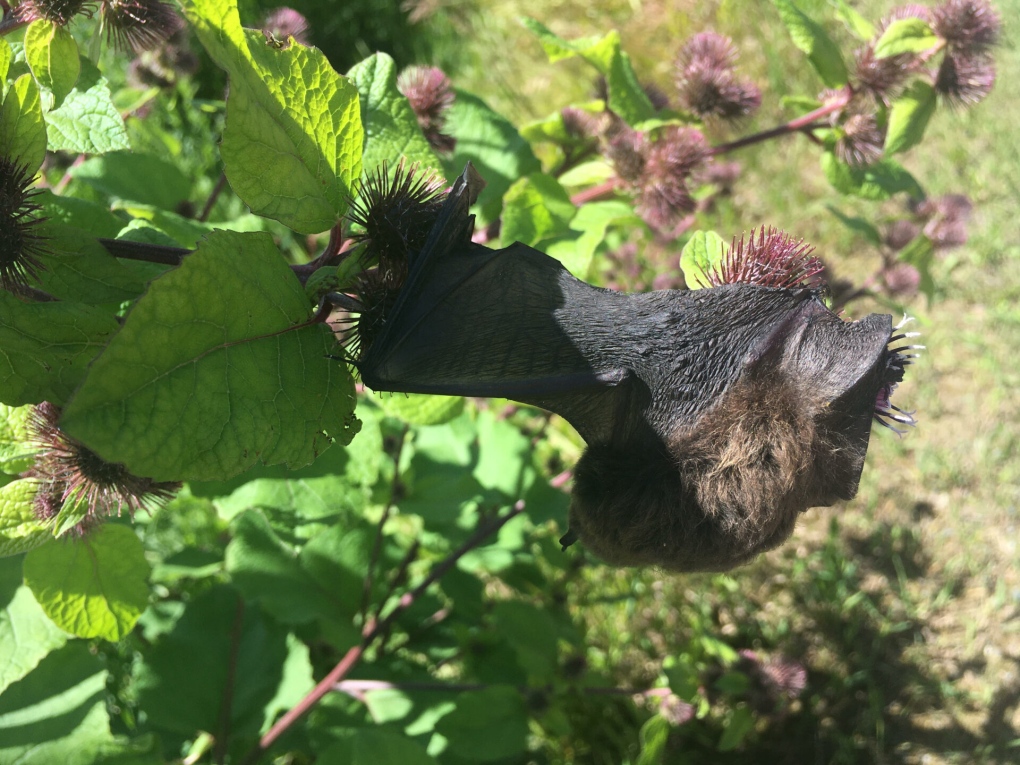More bats getting stuck on invasive B.C. plant, council says
The Invasive Species Council of B.C. is asking the public for help removing an invasive plant that is a threat to local bat populations.
Mary Kellner, a bat conservation co-ordinator for the province's Ministry of Land, Water and Resource Stewardship, recently reached out to the ISCBC about the invasive plant known as burdock, according to a post on the council's website.
Kellner shared several photos that had been provided to the ministry by members of the public, each of them showing bats that had become stuck on the plant's burrs.
“The bat community has been aware of the potential for bats to be snagged on burdock for many years," Kellner said in the ISCBC post.
"We always get intermittent reports and photos, but numerous reports have come in this year already … Of course, these incidents are just the ones that people see and report – we don’t really know the full scope of this problem.”
Burdock is considered a noxious weed in many parts of B.C., and is typically found near fence lines, on roadsides and in streambanks. The ISCBC says it spreads "very easily," with one plant producing up to 16,000 seeds.
“Bats, birds, basically any small animal can get stuck in burdock, notorious for its rounded flower heads with hooked spines (burrs)," said Allison McCabe, senior lead for outreach at ISCBC, in the post.
"These burrs are so sticky they were the inspiration behind Velcro."
 A bat is seen stuck in burdock near Hazelton, B.C. (photo: S. Carle)
A bat is seen stuck in burdock near Hazelton, B.C. (photo: S. Carle)
Burdock is just one of many threats B.C.'s 15 bat species currently face, along with habitat loss, declining insect populations, and cat predation, according to the council.
The looming threat of white-nose syndrome – a fungal infection that is present in Washington State and Eastern Canada and has been spreading toward B.C. – is also a concern.
The ISCBC says the public can help B.C.'s bat population by removing burdock and preventing it from going to seed.
"While cutting is best done before the flowering stage, you can remove after it flowers – be sure to double bag and take to the landfill," the council's post reads.
"To remove the plant, sever the deep taproot at least 8-10 cm below the soil surface, or dig it out completely."
The ISCBC also asks members of the public to report invasive plants, including burdock, through its online form or by emailing Lisa Houle at lhoule@bcinvasives.ca.
CTVNews.ca Top Stories

Canadian family stuck in Lebanon anxiously awaits flight options amid Israeli strikes
A Canadian man who is trapped in Lebanon with his family says they are anxiously waiting for seats on a flight out of the country, as a barrage of Israeli airstrikes continues.
Suspect in shooting of Toronto cop was out on bail
A 21-year-old man who was charged with attempted murder in the shooting of a Toronto police officer this week was out on bail at the time of the alleged offence, court documents obtained by CTV News Toronto show.
Scientists looked at images from space to see how fast Antarctica is turning green. Here's what they found
Parts of icy Antarctica are turning green with plant life at an alarming rate as the region is gripped by extreme heat events, according to new research, sparking concerns about the changing landscape on this vast continent.
DEVELOPING 2 dead after fire rips through historic building in Old Montreal
At least two people are dead and others are injured after a fire ripped through a century-old building near Montreal's City Hall, sources told Noovo Info.
Yazidi woman captured by ISIS rescued in Gaza after more than a decade in captivity
A 21-year-old Yazidi woman has been rescued from Gaza where she had been held captive by Hamas for years after being trafficked by ISIS.
A 6-year-old girl was kidnapped in Arkansas in 1995. Almost 30 years later, a suspect was identified
Nearly 30 years after a six-year-old girl disappeared in Western Arkansas, authorities have identified a suspect in her abduction through DNA evidence.
Dolphins 'smile' at each other when they play and to avoid misunderstanding, study finds
For humans, flashing a smile is an easy way to avoid misunderstanding. And, according to a new study, bottlenose dolphins may use a similar tactic while playing with each other.
Pit bulls in B.C. pet mauling tested positive for meth, cocaine, says city
Three pit bulls involved in a deadly attack on another dog last month in Kamloops, B.C., tested positive for methamphetamine and cocaine, and the city is going to court to have them put down.
Tax rebate: Canadians with low to modest incomes to receive payment on Friday
Canadians who are eligible for a GST/HST tax credit can expect their final payment of the year on Friday.

































